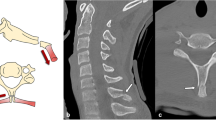Abstract.
The present study investigates the diagnostic value of rotatory computed tomography (CT) examinations in normal subjects and patients with whiplash associated disorders (WAD), with the aim of reproducing earlier findings of rotatory CT studies. Forty-seven WAD patients with persistent complaints after a rear-end collision (non-cranial contact acceleration/deceleration trauma) were enrolled in this study. To guarantee a maximally homogeneous study population, only WAD patients with a marked passive cervical retroflexion restriction were included. Transversal CT slices in left and right rotation were made for all cervical levels (the skull included). CT slices in neutral position were used to reconstruct partially depicted vertebrae. Absolute rotatory values were estimated according the method of Penning and Dvorak. For all levels the relative rotatory (RR) value was calculated by dividing absolute rotation values of a particular cervical level by the corresponding total cervical rotation. The measuring error was estimated by comparing the findings of two separately performed measuring procedures. Two age groups of WAD patients were formed. A younger group was matched for age with 26 normal healthy volunteers (the original data of an earlier study). The use of neutral CT slices for reconstruction of a partially depicted cervical vertebra resulted in a measurement error of 1.9° at the level of C0/C1 (occiput/atlas) and 3.5° at C1/C2. Suspected hypermobility as defined by Dvorak was rare in our WAD patients (6.4% C0/C1 and 10.6% C1/C2). RR values at C0/C1 were significantly larger in 79% of the WAD patients. Discriminant analysis of the RR values showed 80% correctly classified WAD patients. Only 11.5% of the normal subjects were classified as false-positive. Since no hypermobility was found at C1/C2, a traumatic lesion of the alar ligaments is less likely. It was concluded that the use of absolute rotation values in rotatory CT scan procedures has a low diagnostic value in WAD patients. Excessive RR values were only found at C0/C1. A traumatic lesion of the ligaments at C0/C1, which prevent vertical translation of the skull with regard to the atlas, is hypothesised. The results of the discriminant analysis of the RR values make this method applicable for the individual WAD patient in daily practice.
Similar content being viewed by others

Author information
Authors and Affiliations
Additional information
Electronic Publication
Rights and permissions
About this article
Cite this article
Patijn, J., Wilmink, J., ter Linden, F. et al. CT study of craniovertebral rotation in whiplash injury. Eur Spine J 10, 38–43 (2001). https://doi.org/10.1007/s005860000212
Received:
Revised:
Accepted:
Issue Date:
DOI: https://doi.org/10.1007/s005860000212



